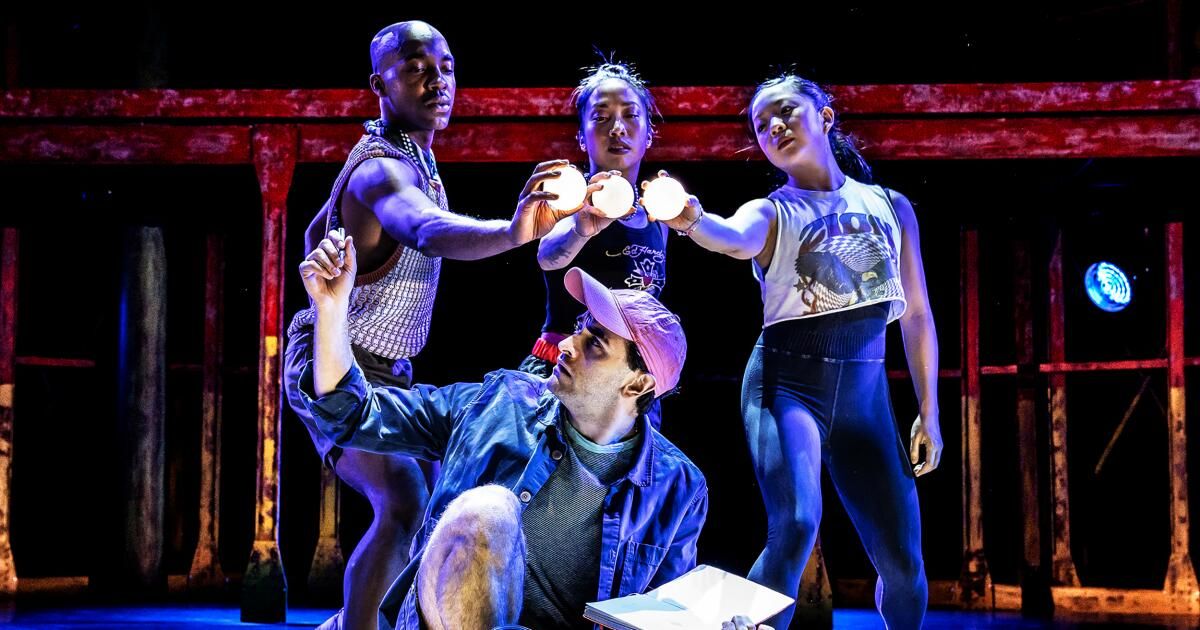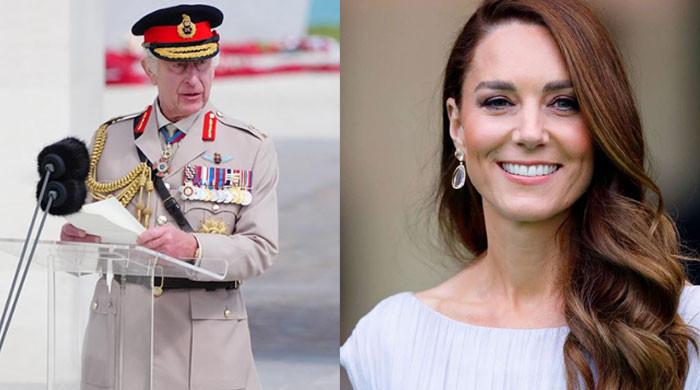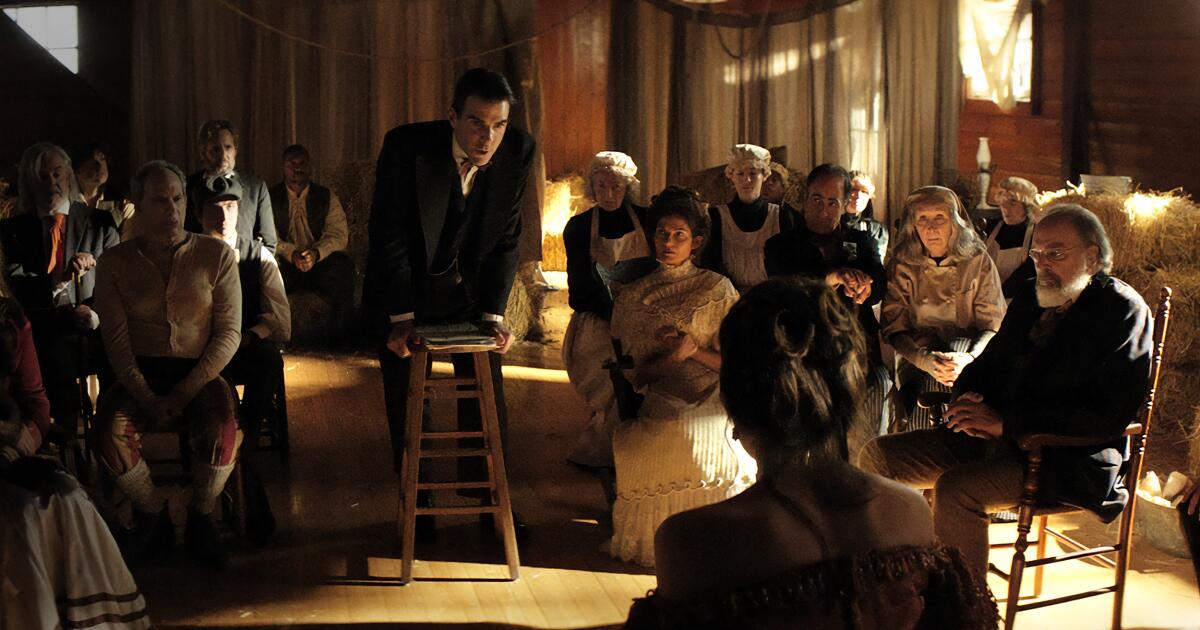“Illinoise,” a trippy dance musical based on Sufjan Stevens’ 2005 concept album “Illinois,” offers a fitting end to a Broadway season that seemed happiest when operating beyond conventional assumptions and practices.
That the piece (I hesitate to call this delicate hybrid a show) is more dance than musical is not so important. Let the theater awards categories expand to accommodate new forms and visions. The production, which was at the Park Avenue Armory earlier this season, arrived at the St. James Theater in the role of deus ex machina, rescuing Broadway from its rigid habits.
All the elements of a musical are found in “Illinoise.” The music, which mixes indie folk, alternative rock and chamber pop, creates a space for collective reflection. The lyrics, poetic fragments that blur the line between the personal and the historical, the symbolic and the idiosyncratic, the living and the dead, emerge from the corners of the inner life. The choreography translates this inner struggle into athletic grace.
Admittedly, the book by playwright Jackie Sibblies Drury and director-choreographer Justin Peck is more of an evolving scenario than a discernible drama. But the dream production is thematically anchored. A compromise is achieved between theater's penchant for history and dance's penchant for abstraction, allowing audience members to connect narrative threads in their own way.
Personally, I was relieved not to witness another forced marriage between script and score. When the book musical works, as it gloriously does this season with the revival of “Merrily We Roll Along,” there is nothing more satisfying. But for every Stephen Sondheim masterpiece there is a barrage of jukeboxes and movie musicals eager to cash in on moviegoers' indulgent nostalgia.
“Illinoise” is conceived in a comprehensive way. The structure of the work seems to have arisen organically from the artists' response to each other, inspiration begetting inspiration. The result, based on love, is the cleanliness of the path.
Three vocalists (Elijah Lyons, Shara Nova, Tasha Viets-VanLear), decked out in street-art butterfly wings, are perched on platforms. Her magnificent, otherworldly singing, accompanied by an orchestra elevated elsewhere in Adam Rigg's urban scaffolding, gives the music a celestial breadth that extends beyond the consciousness of a single singer-songwriter.
I'm not intimately familiar with Stevens' album, but I was caught up in the variety of songs that go beyond rational thought. The words are lost and the meaning is lost, but the sense of emotional urgency, of delayed but inevitable recognition, appears.
The company of 12 dancers is highly individualized, distinct in presence and style of movement. Each figure suggests a unique background, but certain facets of the being are repeated. The difficulty inherent in coming of age is shared in a piece that traces the movement from innocence to experience. Time, always moving, makes it impossible for anyone to catch up. However, the race for life can only last so long.
Henry (Ricky Úbeda), a quirky, unremarkable young man in shorts and a pink hat, appears to be fleeing painful memories. He and his family arrived at a clearing where others gathered to share his stories. The surroundings of the campfire, outlined with lanterns, suggest a support group. The phrase “grief circle” was my own silent articulation for this communal stopping point.
Other dancers hold illuminated orbs around Henry, reminding him of their spiritual presence. He is reluctant to reveal his secrets, but it is only a matter of time before he joins the others in unburdening his soul to him.
Gaby Díaz and Ben Cook in “Illinoise”.
(Liz Lauren)
The stories that precede his are choreographic representations of song performances. The show offers titles that will spark meaning for devotees of the album: “a story about Jacksonville,” “a story about Zombies,” “a story about John Wayne Gacy Jr.” and “a story about the man from Metropolis.” These ethereal chronicles are about ancestry and belonging, the haunted house of American history, murder and guilt, and the longing of a superhero balanced with the luminous reality of vulnerable humanity.
The images evoke a supernatural mosaic of revenants and Superman. The content of these nightmares and obsessions does not always resonate. Sometimes the feeling is supernatural; other times, the literalization of the songs' ideas flirts with cheesiness. But the intensity of the dancer's relationship with the material says it all.
It is the act of catharsis, the exorcism of emotional demons, that makes “Illinoise” so engrossing. Peck illustrates this process through the geometry of his staging. He routinely has her dancers separate from her grouped groups to take advantage of a moment of confession before reuniting in the collective embrace.
Henry's story is about first love and the devastation of early loss. Three figures dominate his mental landscape. Carl (Ben Cook), Henry's best friend and first love. Shelby (Gaby Diaz), Carl's mutual friend and first love, who falls seriously ill. And Douglas (Ahmad Simmons), who sees and claims Henry's adult heart with an acceptance that can seem strange and even alarmingly miraculous.
If Henry's story were crafted through dialogue, it would be difficult for him to escape sentimentality. But it's the universal pattern, the way Henry's experience echoes our own, that transcends the handling of specific plot points.

Ben Cook, close-up, and Ricky Úbeda in “Illinoise”.
(Liz Lauren)
Peck, a prolific presence at New York City Ballet who choreographed dance sequences for Steven Spielberg's 2021 film “West Side Story,” embraces the inner journey strongly. His choreography embraces the inherent difficulty of being.
Tranquility in the world, once lost, is difficult to recover. This common history is communicated in a dance vocabulary of purposeful steps overcoming invisible burdens. When moments of virtuosity erupt, as they do when Byron Tittle unleashes a spectacular display of Olympic touch, the effect is a victory of both spirit and mortal flesh.
“Illinoise” becomes a road trip, as Henry ventures to Chicago and then New York, testing himself in the big-city landscapes that are incorporated into Rigg's scenic design. The visual image, markedly enhanced by Brandon Stirling Baker's lighting and Reid Bartelme and Harriet Jung's costumes, suggests the sentimental education of wandering artists seeking to recompose the losses and gains that are an inextricable part of maturity.
This hasn't been a banner year for new musicals on Broadway, but with “Illinoise,” the last show I saw this season, I got a glimpse of the majestic future.












